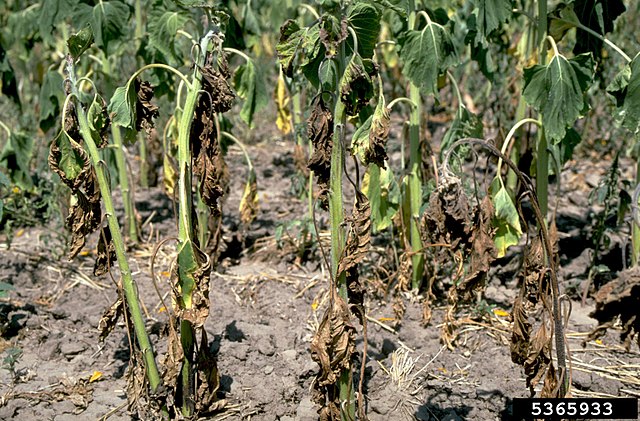This is the tenth and final part of a series on fall tree diseases. This article examines thousand cankers disease and verticilium wilt.
Introduction
During fall, the environment undergoes a drastic shift, with cool temperatures prevailing, and inclement weather often abundant. In this climate, many plant diseases flourish. The following describes some of the most common plant diseases to occur in fall, and how they affect their hosts.
Thousand Cankers Disease (Geosmithia morbida)
Thousand cankers disease is a disease complex that affects walnut trees. The complex begins with the infestation of vulnerable walnut trees by the walnut twig beetle, Pityophthorus juglandis. During its adult stage, Pityophthorus juglandis makes contact with the fungal pathogen, Geosmithia morbida. The adults subsequently bore into the bark of infested trees to overwinter or lay eggs. As the beetles tunnel into the host, they unwittingly introduce the fungus, which germinates in the woody tissue. Once the fungus has become established, it induces the formation of cankers on the diseased branches. Large beetle populations can overwhelm infested trees, causing them to decline rapidly. Infected trees may experience tree mortality within 2 to 3 years of the initial infestation.
Hosts
Thousand cankers disease infects walnut trees. Black walnut is the most common host.
Symptoms of Infection
Unlike other canker diseases, when a tree is infected by thousand cankers disease, the bark does not slough off. Instead, it remains firmly attached to the trunk, preventing the necrotic areas from being easily discerned. If the outer bark is stripped away, the beetle tunnels and branch cankers will often be apparent. Infected parts of the tree may become shallow or sunken. Severely infected trees may exude sap from the beetle tunnels. The sap will often trickle down the trunk, causing a dark amber stain to form on the bark surface.
External symptoms become more visible as the host declines. Once the disease has advanced into the trunk, more branches are girdled. This results in a discoloration of the tree’s crown, which can be widespread, or relegated to individual branches. The leaves of infected trees will often abruptly wilt. The upper portion of the crown will gradually die back. Host trees typically succumb to infection within 2 to 3 years.
Management
- When planting, select varieties of walnut that exhibit an increased resistance to thousand cankers disease. Arizona, California, and little walnut are some of the most resistant varieties.
- The wood from infected trees may be used for commercial purposes, but the bark, phloem, and cambium should be removed first, to reduce the spread of the disease.
- After they have been harvested, walnut trees intended for shipment to garden centers, households, or nurseries should be inspected for the beetle galleries, cankers, or dieback.
- There is currently no chemical treatment available for control of thousand cankers disease.
- Infected trees can be culled to prevent the disease from spreading to healthy trees.
- Areas where infections have been detected can be placed under quarantine to manage the disease.
Verticilium Wilt (Verticilium)
Verticilium wilt is a fungal disease that affects over 400 plant species. It is caused by six species of the Verticilium genus: V. dahliae, V. albo-atrum, V. longisporum, V. nubilum, V. theobromae, and V. tricorpus. Numerous vegetables, fruit trees, flowers, field crops, and woody ornamentals are vulnerable to infection by Verticillium wilt. The symptoms of Verticilium wilt vary between plants. In most infected plants, a general wilting of the stem and leaves will occur. Verticilium wilt infections can prove fatal for many smaller and older plants, as well as for seedlings.
Hosts
Verticilium wilt attacks a wide range of hosts. Trees and shrubs that are commonly infected include ash, black locust, box elder, camphor tree, carob, carrotwood, elm, catalpa, cork tree, elder, elm, flannel bush, fringe tree, golden-rain tree, horse chestnut, pagoda, sassafras, serviceberry, smoke tree, tree of heaven, tupelo, tulip tree, walnut, yellowwood, and juniper. Cabbage, celery, cucumber, eggplant, lettuce, melon, pepper, potato, pumpkin, radish, rhubarb, and tomato are the most commonly infected vegetables. Susceptible flowers include aster, begonia, carnation, chrysanthemum, dahlia, geranium, impatiens, peony, petunia, snapdragon, and sunflower. Vulnerable fruit include barberry, blackberry, black raspberry, select cherries, grape, raspberry, Ribes sp., strawberry, and watermelon.
Symptoms of Infection
When a plant is infected by Verticillium wilt, its vascular system is disrupted. This prevents the proper distribution of water and nutrients throughout the plant. Due to the lack of sufficient water and nutrients, the plant’s stem and leaves wilt. Smaller plants and seedlings are often quickly killed. In larger plants, infections may not be as severe. Many larger plants will stave off Verticilium wilt infections, but may be weakened as a result. Sometimes infection symptoms may be confined to the lower portion of a plant, or localized to a few branches. New growth formed by infected plants will often be stunted. Infected leaves will typically become necrotic, before being shed prematurely.
Management
- Remove and dispose of infected annuals and perennials. Avoid composting diseased plant materials.
- Prune damaged or infected portions of ornamental plants. Sterilize pruning tools between each cut using a solution comprised of nine parts water and one part bleach.
- Plants should be pruned routinely to promote plant vigor.
- Avoid mechanical wounds to plants.
- Ensure that plants are maintained through sound cultural practices. Apply a layer of organic mulch around the base of vulnerable plants to insulate the root system and improve the soil quality.
- Certain plant species exhibit an increased resistance to Verticilium wilt. These plants include apple, beech, birch, all conifers, crabapple, dogwood, eucalyptus, fuchsia, heather, hornbeam, katsura tree, lilac, mountain ash, mulberry, plane tree, poplar, privet, rose, sumac, sweetgum, sycamore, Viburnum sp., and willow. African violet, ageratum, baby’s breath, hollyhock, periwinkle, primrose, and zinnia are popular flowers that are immune to Verticilium wilt. Vegetables that are immune to Verticilium wilt include asparagus and beanpea.
Photo courtesy of Howard F. Schwartz CC-by-3.0


